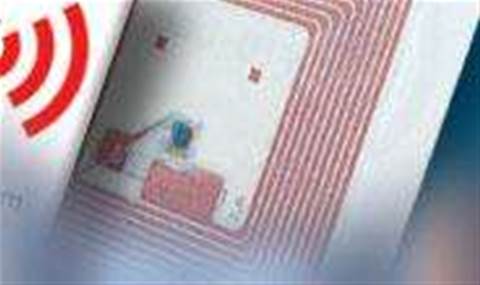Session information is displayed on myriad screens throughout the venue and you could hardly miss halls five and six of the vast exhibition space at Darling Harbour which are packed full of vendors with something to add to the computing experience, as well Microsoft's own teams of experts displaying their various wares.
However there are also mysterious RFID tags in each delegate's conference badge and corresponding square plastic readers hanging over the doorways to each lecture space and exhibition space. But where are these silent sentries sending their information?
The answer was hidden below and behind the main escalators in a dingy room labelled "The Boiler Room" where staff from Breeze were busily collating the RFID hits from the Kenetics readers into a Microsoft BizTalk server running on HP's kit to slice and dice the data into a meaningful display.
That last sentence also got the sponsor naming obligations sorted.
Up on the screens were all sorts of interesting pie-charts and graphs showing how many delegates were attending which sessions and, based on their questionnaire responses, showing their job functions, industry worked in, number of TechEds attended and their tastes in music.
All this data will no doubt make it easier for Microsoft to fine tune future events to better match what delegates actually did over the three days rather than what they said they were going to do.
And the technology will no doubt soon appear at other conferences and events perhaps your favourite nightclub will no longer need someone counting people in and out on the door.
Their RFID scanner could just light up a display telling you how many of your group can fit inside before the capacity limits are breached.
Of course that means you'd need to be wearing an RFID tag of some sort.
How much longer will it be before something like your driver's licence contains a tag?
That would make it harder to claim someone else was at the wheel of your car on its high-speed drive home.
The experiment was also useful for the implementation team RFID is normally used on well-behaved cartons travelling down predictable conveyor belts.
A whole host of interesting problems surface when you're tracking people wandering randomly in and out of doorways, changing direction to chat, popping in to look for friends or just standing still right under one of the readers.
But for now we're only likely to see the technology in use where people have volunteered to participate, which is why this conference full of nerds was a good choice for the experiment.
It's fairly easy to get nerds to agree to anything new in geekland.
And based on the pie-charts your correspondent was looking at, you can expect a lot more dance music rather than hip-hop, rock or classical at the next TechEd nerdfest.
Opinion: Smile, you're on RFID
By
Ian Yates
on Sep 5, 2008 3:45PM

Got a news tip for our journalists? Share it with us anonymously here.
Partner Content

Promoted Content
From Insight to Opportunity: How SMB Service Demand is Shaping the Next Growth Wave for Partners
_(11).jpg&h=142&w=230&c=1&s=1)
The Compliance Dilemma for Technology Partners: Risk, Revenue, and Reputation

Channel faces AI-fuelled risk as partners lag on data resilience, Dicker Data summit told

Tech Buying Budgets for SMBs on the Rise

Shure Microsoft Certified Audio for Teams Rooms




.jpg&w=100&c=1&s=0)
_(8).jpg&w=100&c=1&s=0)







.jpg&q=95&h=298&w=480&c=1&s=1)





